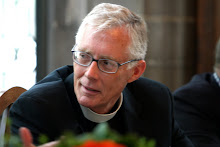Advent: What Are We Waiting For?
When Thanksgiving is over, it isn’t only Black Friday (or, this year, Black Thursday) that tells us Christmas is coming. Our culture labels the days between late November and late December “the holiday season”. In the Christian liturgical calendar, though, this time of year is called the season of Advent, a word we take from the Latin root meaning “coming”. These four Sundays before Christmas together make the time we prepare for the coming of Christ at Christmas.
As in all seasons of the church year, each Sunday of Advent has its own special prayer, called a collect. Here is the collect for the first week of the Advent season:
First Sunday of Advent
Almighty God, give us grace to cast away the works of darkness, and put on the armor of light, now in the time of this mortal life in which your Son Jesus Christ came to visit us in great humility; that in the last day, when he shall come again in his glorious majesty to judge both the living and the dead, we may rise to the life immortal; through him who lives and reigns with you and the Holy Spirit, one God, now and for ever. Amen.
As a season, Advent is organized around the mystery of time. It begins at the end and ends at the beginning. Waiting in expectation for the coming of God into our lives, we begin the season by thinking about the end of time. You’d think that Advent would be an orderly progression from past to future, but it’s actually the other way around. We start with the future and, over four weeks, work our way back to the past. We do that because we understand that God’s self-revelation happens in three ongoing moments: the last day (the end of time), the present day (the here and now), and the first day (the birth of Jesus in first century Palestine). The Sundays of this season work both backward and forward at once. The Fourth Sunday features the archangel Gabriel’s annunciation to the expectant mother Mary. The Third and Second Sundays focus on the warnings and predictions of John the Baptist. The First Sunday starts with us, as we are, today and then jumps forward to “the last day”, when Jesus Christ will “judge both the living and the dead”.
By initially directing our focus to the last day rather than the first day, the Prayer Book asks that we use this season as a time not only to prepare for Christmas but also to pose some larger questions to ourselves. Specifically: what are we waiting for? What is our hope? What would God’s authentic presence in our lives look and feel like?
The Advent season’s simultaneous focus on past and future gives us a way into considering these questions. We get our image of what redeemed, transformed, liberated life will look like by looking back to what we have already seen of that life in the ministry of Jesus and the community he gathered around him. The Christian hope is not vague and gaseous. It is specific and particular. We hope, when all is said and done, to experience God’s love as those gathered around Jesus did. We look back to the first Christmas so that we can look forward to the final one.
So when the collect for the First Sunday of Advent says that Jesus will come at the end of time “to judge both the living and the dead” we should hear that not as a harsh final exam on life given by a divine monarch—but rather as a loving summation made by one who has already loved, healed, taught, touched, and blessed us. We “rise to the life immortal”, in the prayer’s words, through sharing the love, compassion, and forgiveness that continually marked Jesus’s ministry. If we only looked forward, we would do so in fear. If we only looked backward, we would do so with grief. That we can look both ways at once allows us to see the past as the pattern for the future and the future as the completion of a process begun in the past.
The phrase that always arrests me in this collect for the First Sunday of Advent is the one that prays we may receive “grace to cast away the works of darkness, and put on the armor of light”. The vision of future judgment informed by a gracious past and dynamic present gives us a way to organize our preparation for this season. Christmas will come in its own time. It already has. God has been, is, and will be with us. What are we waiting for? We move, in these four weeks, toward the present and future coming of Christ, one that will reprise an ongoing love we already know. This time of waiting is the season’s proper gift. To make ourselves ready, let us remember that what we really hope for at Christmas is what we have already seen in the life of Jesus and in the expressions of human compassion and mercy we know in the fabric of our lives. Let us cast away the works of darkness, and put on the armor of light. Jesus is coming toward us. And even in this holiday season we are moving toward him and the One who sent him.
Gary Hall

